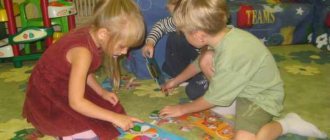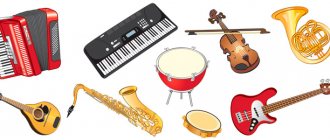Senior group. Senior preschool age. Children 5-6 years old
Children's project "Let's learn everything about viruses" in the senior group Children's project "Let's learn everything about viruses"
in the senior group Information card
of the project 1 . Full name of the project : “Let's learn everything about viruses”
in the senior group.
2. Author of the project : Elena Vladimirovna Vysotskaya. 3. Project : Elena Vladimirovna Vysotskaya.
4. Personnel: teacher…. Family project in the senior group “Cooking at home with the children” Project : children and parents of the senior group Implementation period: medium term - 1 month. Project type : educational, practice-oriented, creative. Problem: learn from your mother and grandmother the skill of cooking and baking from preschool age Relevance: There is nothing tastier and...
Educational - research project “The Amazing is Nearby”
Educational - research project “The Amazing is Nearby”
Prepared by educators: Krasikova T.L.
Stroganova E. V.
Orenburg 2021
Type of project: short-term 2 weeks (from January 18 to January 29).
Project participants: children 3-4, 4-5 years old, teachers, parents.
Relevance of the problem:
Preschool children are by nature inquisitive explorers of the world around them. They look at the world around them with great interest, but they don’t see everything, sometimes they don’t even notice the main thing. And if there is a teacher nearby, who wonders with them, encourages them not only to look, but also to see, the children will want to learn even more.
Fascinating observations on a walk, research activities, educational games and artistic expression will help children in an accessible form to understand and comprehend the purpose of objects, their properties, the materials from which they are made, as well as make their first discoveries and conclusions of cause-and-effect relationships and patterns.
The goal
of the project :
to create conditions for expanding ideas about the properties of the materials from which the objects around us are made.
Project objectives :
• expanding and consolidating ideas about the materials from which the objects around us are made (paper, wood, metal, plastic).
• development and support of children's cognitive interest in the existing problem.
• development of the child’s cognitive-search activity, the ability to establish cause-and-effect relationships, analyze, and draw conclusions about the properties and qualities of materials.
• development of speech skills: exchange information (dialogue speech, talk about an object, the material from which it is made, its properties (monologue, coherent speech, form and establish cause-and-effect relationships (explanatory speech)
.
Expected result:
• children's understanding of materials will expand: wood, paper, metal. plastics their qualities and properties.
• children determine how and where these materials can be used.
• children have an idea of the safe and careful use of objects made from different materials (
weak, rough, brittle, heavy
)
.
• personal competencies characteristic of children’s age will be formed: cognitive activity, interest, independence, initiative
• children will master the ability to establish cause-and-effect relationships between the properties of a material and its use
Preliminary work:
• selection of advisory material for parents.
• project development.
• preparation of equipment and materials for experimentation and productive activities of children.
• enrichment of the children's laboratory.
Interaction with family:
• familiarization with the topic of the project
•participation in collecting a collection of materials: paper, wood, metal, plastic.
•consultation: “Developing cognitive interest and curiosity in a preschool child”
Project implementation stages :
Stage I – preparatory.
• study and analysis of scientific research, methodological literature, Internet resources on this issue, selection of software and methodological support, selection of visual demonstration material.
• development of project content:
• planning upcoming activities aimed at implementing the project.
Stage II is the main one.
• organizing and conducting various training and development activities.
Stage III is the final stage.
• creation of the exhibition “World of Wood”, “World of Paper”, “World of Plastic”.
Project implementation plan .
Group tour :
“What materials are the objects in our group made from?”
2. Conversation with children:
“Objects and various materials” (inclusion in the project)
3. “Properties of plastic”
Experiment No. 1 “Properties of plastic.”
Goal: to introduce children to plastic and its properties.
1. Invite children to examine and examine plastic objects:
spoon, glass, plate, etc.
- touch to the touch (smooth).
-try to break (fragile, easily broken)
-pour water into a glass (does not allow water to pass through)
-look through them (sometimes transparent and not transparent)
Problem situation: “What objects can be made from plastic (only for dolls, the real one will break and melt in the fire).
4.
“Properties of metal”
Experiment No. 1 “Properties of metal”.
Goal: to introduce children to metal and its properties.
1. Invite children to examine and examine metal objects: a metal plate, a paper clip, a spoon.
- touch to the touch (smooth, cold).
-try to break (strong, hard)
2. Experiment No. 2 “Drowning or not drowning”
First, plastic and then metal balls are released into a container of water, one by one, and see what happens. Why did the metal one drown? It's heavier.
3. Conversation: “What objects can be made from metal?”
Problem situation: “Can a chair be made of metal? (Yes). Yes, but it will be very heavy, because metal is heavy.
4. Experiment No. 3 “Conductivity”
Take a plastic object in one hand and a metal one in the other. Which one is warmer? (conclusion – the metal is cold).
Take a metal plate and place it on the battery. Wait a little and touch it.
– What happened to the plate (it became warm).
Conclusion: metal heats up quickly.
5. Experiment No. 4 “The metal is magnetized.”
Place small metal objects (paper clips, nails) and plastic on the table. Take a magnet in your hands and hold it over them. What will happen? All metal objects will be attracted to the magnet. Conclusion: metal objects are attracted by a magnet.
6. Experiment No. 6 “How can you get a paperclip out of water without getting your hands wet.”
Pour water into a transparent container and place paper clips. All the paper clips will end up at the bottom because they are made of metal, and we know that metal is heavy. How to remove a paperclip without getting your hands wet. Using a magnet, we take the paper clips out of the water, bringing the magnet to the paper clip from the outside and lifting it up.
5.
“Properties of wood”
Conversation: “What objects can be made from wood.”
Word game “Say a word.”
Experience: “Sinks or doesn’t sink”, “Wood is warm or cold”, “Breaks or doesn’t break”, “Experience with a sharpener”.
Didactic game “Find objects made of wood.”
Relaxation “Pass the magic wooden wand and tell the property of the tree.”
6.
“Properties of paper”
Conversation: “What is paper made from?”
Experience: “Paper wrinkles and tears,” “Comparison of paper,” “Paper makes a sound,” “Does it get wet in water or not.”
7. Conversation “Rules for safe handling of objects made of different materials.”
8. Game “Clean up the chest.”
Purpose: classification of objects according to the material of manufacture.
Material: chest containing objects made of paper, plastic, wood, metal, 4 boxes.
Procedure: Invite children to disassemble objects according to their materials. Take an object and name what it is made of. And put it in a certain box.
9.Creating a collection:
“The World of Wood”, “The World of Paper”, “The World of Plastic”.
Application. Consultation for parents.
A child is inquisitive by nature. He is interested in everything new, unknown. He has discoveries every day: he learns that paper tears, ice melts, stone sinks in water, and wood floats on the surface.
The desire to know often fails children: they accidentally cut napkins because they want to find out whether it can be cut, or gut toys in order to find out why they move. The child grows, his curiosity about the environment and the unfamiliar increases.
Why is it necessary to raise children to be inquisitive?
This is necessary in order to form cognitive interest, which also manifests itself in the desire to learn new things, but is aimed at a certain aspect of life, a certain phenomenon or object. In turn, cognitive interest is an ally of volitional effort in achieving a goal and overcoming difficulties. On its basis, creative initiative, independence in solving mental problems, and an active attitude towards the environment develop, which is opposed to the indifferent, thoughtless assimilation of knowledge and the performance of work without the strain of thought, without the joy of success. But all this is the key to successful schooling. After all, a certain category of high achievers consists of the so-called “intellectually passive” children. They are characterized by a negative attitude towards mental work and a desire to avoid mental activity. The reason for the “intellectual passivity” of children is the cognitive interest that was not formed in the preschool years.
How to develop curiosity and cognitive interest?
This is done in everyday life, in kindergarten, in classes, in games, in work, in communication, and does not require any special activities. The main condition is to widely familiarize children with the phenomena of life around them and cultivate an active, interested attitude towards them (take children on excursions, walks, observe, compare, read books together).
For curiosity to be creative, it must be cultivated. When parents interfere with his research activities, the child is unlikely to want to continue it or, at least, will begin to acquire knowledge with much less persistence.
Listen to his questions and answer them. Toddlers have a lot to learn, so it's no surprise that when they start talking, their questions start pouring out. Of course, I really want to after the fiftieth question “What is this?” remain silent or even pull the child back, but try not to do this.
All your baby's questions deserve an answer. If he does not get an answer to his question or the answer is not satisfactory, for example, when he is told “because” or “you are too small to understand him,” he may stop asking. Of course, you need to answer, taking into account the age of the child, simply and briefly.
Accept your child's exploration and encourage it. The world is full of exciting things, and although this is often a pain for parents, children need to experiment with it. Therefore, resist the urge to pull your baby down for the sake of maintaining cleanliness and order: you may interfere with the acquisition of the experience necessary for learning.
An inquisitive child wonders: what happens if you pick the leaf of an indoor flower? What happens if you throw sand in a playmate's face or throw a toy car across the room? If the experiment becomes destructive or dangerous, you need to stop it, but you need to make it clear to your child that you are not satisfied with the result, and not the process itself. Try to direct your child’s research thoughts to another object. If you don’t want to make your child a scientist while saving the house, come up with experiments that can be performed under your control: blow the fluff off a dandelion, sift sand through a sieve, mix food coloring with water.
Encourage your child to improvise. The baby is taught not only by the real world, but also by the world of fantasy, thanks to books, movies, videos, and television programs. Encourage any kind of play. In his own imagination, a child can become an adult on a picnic, a squirrel in the forest, Puss in Boots or Brer Rabbit - in general, whoever he wants.
Do not encourage your child to watch TV often. The easiest way to turn off your brain is to turn on the TV. Yes, a child can glean information from some carefully selected children's programs, but this is passive learning. It does not help children learn independently and be an active participant in the cognitive process. Therefore, try to sit in front of the TV less, and when your baby is watching, watch with him.
Incorporate learning into your daily life. This is achieved with the smallest
through our efforts. You can introduce your child to the numbers “Should I give you one cookie or two?”, to the colors “Are you going to wear a red sweater or a blue one?”, to the letters “You can see the letter “M”, “Mom” and “milk” begin with it. Your goal is not to teach your child to count or read by the age of one and a half years, but to spark interest in these areas of knowledge and create a foundation for future learning.
Learning should be fun. If a child feels that he is being forced to study, that he is being scolded or ridiculed for his failures, or that he is being given tasks that are difficult for his age, then he will fear learning rather than love it. Set an example. Let the baby understand that
You also love to explore the world around you, and learning continues throughout your life. The desire to learn—for both you and your child—is contagious.
How to answer children's questions:
1. Treat children's questions with respect, do not brush them off.
2. Listen carefully to the child’s question, try to understand what interested the child in the subject or phenomenon about which he is asking.
3. Give answers that are brief and understandable to a preschooler, avoid complex words and bookish figures of speech.
4. The answer should enrich the child with new knowledge and encourage further reflection and observation.
5. Encourage the child’s independent thinking by answering his questions in response: “What do you think?”
6. In response to your child’s question, try to involve him in observing the life around him, re-read the book, and look at the illustrative material with you.
7. When answering a child’s question, influence his feelings. Cultivate in him sensitivity and tactfulness towards the people around him.
8. If the answer to a question is beyond the child’s understanding, do not be afraid to tell him: “While you are still small. You’ll go to school, learn to read, learn a lot and be able to answer your own question.”
Recommendations for parents:
1. Take your children on excursions more often, observe, discuss.
2. Conduct small experiments with objects at home and outside.
3. Listen to the child’s reasoning without interrupting.
4. Do not say the answer if the child is mistaken, but only correct his train of thought in the right direction.
5. Read educational books with your child.
6. Explore various objects that are around you.





